
Background
Ecuador’s disbelief as the opening goal of the 2022 World Cup was disallowed by new semi-automated offside technology,[1] Germany’s wing-shaped, maroon graphic jersey[2] worn by Mario Götze as he clinched the winner in the 2014 finale, and Andrés Iniesta driving the Jabulani, an iconic football of the 2010 edition,[3] into the bottom left corner against the Netherlands – all these instances pose a common underlying element that lies unvisited in the heat of the moment yet significant in the aftermath – intellectual property. While football fans are rightfully celebrating or contesting these sentimental moments, various discussions still pertain around the use of technology as modern day advancements to football or the aesthetically eye-pleasing designs on football jerseys or even catchy terminologies unique to the sport and its associated products.

The FIFA World Cup’s viewership grew to an astonishing figure of 3.572 billion in 2018 and the final witnessed 1.12 billion viewers worldwide.[4] With all eyes on Argentina and France, the tussle may outview all its predecessors and reinstate the well-established premise of football being the most popular sport in existence. Qatar has reportedly spent 220 billion dollars in preparations for the 2022 tournament[5] and those ranging from labourers to players have borne the mental and physical brunt leading up to the final on Sunday. Drawing from the Lockean Labour theory, intellectual property is the reward conferred upon persons for their efforts[6] and in the context of football, for all the viewership generated through the efforts of all those involved, monetisation and recognition are two key outcomes achieved by various means in the sport. In this article, the authors discuss and contextualise the essence of Intellectual Property in the FIFA World Cup by delving into major developments surrounding patents and trademarks across various jurisdictions, including but not limited to Semi-Automated Offside Technology, Qatar’s fresh IP Legislation and FIFA’s sponsorship structure.
Essentials of Football: Industrial Advancements and Patent Law
One ball, two goal posts, twenty two players, and thousands of fans are many constants the beautiful game has witnessed till date. However, the standard of technology has grown tenfold and proportionately, so has the ease of playing and administering modern day football. From the likes of the ball itself to goal-line technology, many would claim that the game is no longer the same as it was once before, be it for the better or the worse. Regardless of their outcome, football inventions have been protected by patents and their applications date as far back as the 1860s. Listed below are some patents for disruptive technologies within the industry –
Patentability of the ball and shoes
For a patent to be granted, most countries require the following patentability criteria to be met – validity of subject matter, novelty, inventive step, and industrial applicability. To a lay person of the 21st century, a football may not meet any of the criteria as it has been constantly available in the same form over the years, and one would even question the need for a patent on a product or process whose knowledge is so common. As patent law would have it, inventions are released into the public domain after their fixed period of twenty years (in India)[7] expires and thereafter, can be appropriated and worked upon to create the next standard of innovation. Similarly, as is the case with a football, several iterations of the ball and its constituents have received patents for certain technological advancements. Standards have also been set for uniformity across matches around the world.
In 1844, Charles Goodyear received a US patent for ‘Improvement in India-Rubber Fabric’. It was worked through the manufacturing of inflatable rubber bladders, which is the primary component of a football.[8] His vulcanised rubber footballs were used in U.S. matches in 1863. The patent being restricted territorially to the U.S. and not having been pursued elsewhere could account for the ‘larger entrepreneurial opportunity’ available in countries like England and Scotland amidst growth and interest in the sport.[9] While there may not be a direct correlation, the patenting of important constituents of a ball, thereby, decreasing its availability in the market, could potentially explain why the U.K. has always ranked higher than the U.S. in international football even though their origins trace back to similar eras. In the early 1870s, the shape and size of the ball was standardised, and along with the rules of the game were adopted by the International Football Association Board (IFAB) in 1886. FIFA became a member of IFAB in 1913 and has since been following its ‘Law 2’ regarding specifications about shape, size, pressurisation, and weight of the ball, thereby, negating the possibility of these features receiving patents until and unless there were significant changes and benefits in utility.[10] An example of this exception would be the Teamgeist (World Cup 2006 football) which had reduced number of panels, increasing its uniformity regardless of where the shot is taken from and ensuring its accuracy in flight.[11] European Patents EP 1 578 504 B1, EP 1 080 745 B2 and EP 1 424 105 B1 elaborate the reduced panel structure along with thermal bonding of the same to increase its waterproof ability.
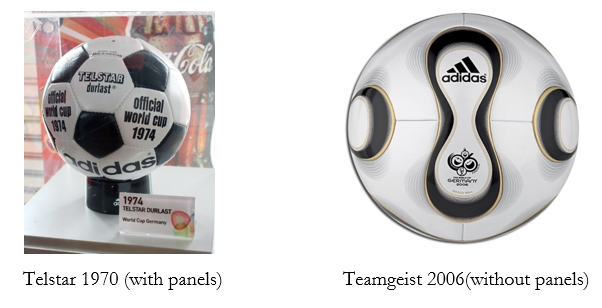
While shoes may appeal to be a matter of design or trademark, patents are also applicable in case of increased functionality. Dating back to the Germany’s 1954 triumph, their shoes provided greater interchangeability in terms of studs. Previously, studs were nailed onto a sole which was later sown with the shoes. In case of replacement of the studs, resoling of the entire shoe was inevitable. This proved to be an issue when weather conditions required different types of studs to adapt and provide grip accordingly, and the same was solved through inventions patented in German patents DE1737733U and DE1695594U. These shoes were built in a manner that permitted exchange of screw-in studs depending on weather conditions and partly played a role in their rainy day wins.[12] A more modern example of a patented football shoe would be the popular Adidas Predator Edge (Australian Patent No. 650081) where the claim is to increase surface area between the ball and the shoe during a lateral kick.[13]
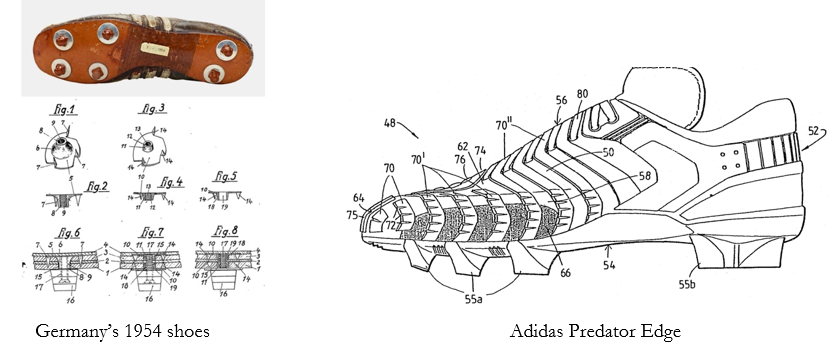
Goal-Line Technology, VAR, and Semi-Automated Offside Technology: Enhancements for the Referees
For time immemorial, referees have been successful in their decisions surrounding free-kicks, penalties and offsides amongst others but on occasion, especially when of large consequence, they have faced criticism for what is most likely to be human errors. While a few cases of corruption may occur,[14] it is largely the human eye that is unable to view all angles, thereby, resulting in wrong decisions that could potentially end a team’s cup/league run.[15] Argentina fans probably experienced as much discomfort as Gonzalo Higuain, who was kneed in the face by goalkeeper Manuel Neuer, and were left in dismay upon learning that it was not ruled as a penalty but a foul was awarded in favour of Germany.[16]
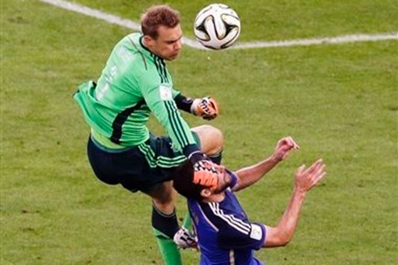
A simple yet elegant solution to the problem would be to develop technology that would provide the referee with an extra set of eyes – enter Goal-Line technology, Video Assistant Referee technology and Semi-Automated Offside Technology. As a combination of two technologies, namely, the Hawk Eye system and the Magnetic field system, Goal-Line technology enables referees to view if a ball has crossed the goal-line and decide upon awarding a goal or disallowing the same.[17] The former system, granted in patent US 5 908 361, implements six different high speed video cameras that position the ball based on the triangulation principle. The latter, in EP 1 596 945 B1, has cables placed around the goal and sensors within the ball which aid in determining the exact position. Goal-Line Technology has largely been successful in its usage, but Video Assistant Referee Technology and Semi-automated Offside Technology have received their fair share of objections.
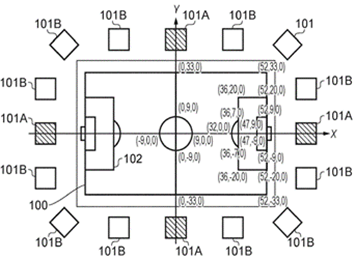
In the 2022 World Cup, VAR has been used side by side the Semi-automated Offside Technology for the first time[18] and is based on the Hawk-Eye system. A Sony group named Hawk-Eye Innovations has supplied this system and it has been detailed in European Patent Application No. 20210667.0 as per which static and rotatable cameras situated around the pitch are used to capture a 3D image of a football or a player which hence aid in deciding offside positions. Furthermore, the connected ball technology, developed in collaboration with KINEXON, is used in Al Rihla (2022 World Cup Football). Its technology has been documented in U.S. Patent No. 11,150,321 and is based on pure radiolocation measurements.[19]
All these forms of technology have mostly benefitted football but have been criticised to take away the originality and continuity of the fast-paced sport.[20] Questions raised about them will be answered in due time, with specific situations such as those faced by Ecuador and other countries in this world cup being re-examined to assess efficiency of the proposed models.
Trademark Licensing, Sponsorship and Protection in the World Cup
Trademark Trends in Football
Trademarks include an e-identity that is a mix of the name, logo, slogan, design, colour, brand performance, etc. that help the supporters feel that the brand is reliable and invokes emotions of closeness.[21] The brand creates the history of the national football team and ties the experiences of the fans into the narrative, which is then tied and monetized by slogans and trademarked logos that differentiate teams and players. Recently, the European Union IP office released a ranking of football players based on the number of EU trademarks they own. The ranking was topped by Ronaldo with 5 EU trademarks, following Mbappé who had also got his slogan trademarked (“Moi tu m’parles pas d’âge” –”Donʼt talk to me about age”).[22]

Apart from slogans and logo trademarks, the football jerseys are also a great monetary source as they attract sponsorship deals. While fans stay loyal to one team, companies like Nike and Adidas sponsor many professional teams across the globe as they want their brand to be connected to sports. Sport helps in developing synergies between a team and the jersey making brand, the sponsor. The jersey becomes an advertising space available for lease from the team. Sports are generally seen as corporate-friendly because they promote governance ideals such as teamwork, meritocracy, and dedication not to mention hierarchy.[23]
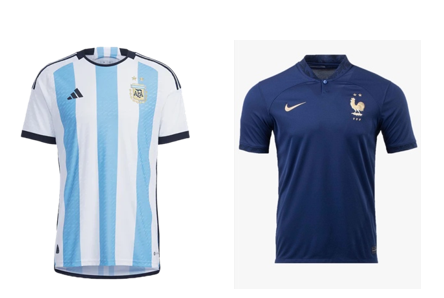
A trademark license such as the one described above determines the relationship between the owner of the trademark (licensor) and the producer of the goods/services, such as the jersey, to which the mark is attached (licensee). Even technology licenses are important for companies that manufacture sports related equipment. These can be helpful in licensing in the tech developed by other companies or licensing out home-grown tech. such licensing and merchandising creates room for strategic marketing and increasing earning potential.[24]
FIFA’s Three Tier Sponsorship Structure
The earning regime in FIFA is usually based on a three-tier sponsorship structure that has FIFA partners at the top, the World Cup Sponsors at the second tier and National Supporters in the third tier for each FIFA event. The FIFA Partners are highest in the hierarchy of association with FIFA and FIFA events and catalyse the development of football around the world. The Sponsors have rights to the FIFA Confederations Cup and the World Cup globally. But the main rights of the sponsors are brand associations, use of products for marketing and exposure. While the national supporter tier helps companies promote FIFA events in domestic market.[25]
Qatar’s endeavours at being Trademark Friendly
Qatar launched its National Vision 2030 in 2008 to become a sustainable and thriving knowledge-based country. Since then, Qatar has been catering towards this goal by economic diversification and hosting major sports events.[26] Hence, Qatar is indulging in brand advertising where the more the team is successful, the more the value of the brand and this increases the spending power of the sports organisation. The recent legislation called FIFA IP Law No. 11 of 2021 on the Protection of Trademarks, Copyrights and Related Rights of FIFA has been enforced to help Qatar in hosting the World Cup. The legislation helps in protection of FIFA’s IP rights by easing the IP registration and recognising FIFA trademarks as ‘well-known marks’.[27] Hence, protecting them under the Paris Convention for the Protection of Industrial Property (1883), which had been signed by Qatar. The FIFA IP law has included an exception to FIFA from submitting a written statement under article 45(5) of the Law No. (7) of the year 2002 on the Protection of Copyright and Neighbouring Rights (“Copyright Law”).[28] Further, the registration and use of FIFA’s IP rights even in domain names is prohibited under chapter 6 of Law No. 10/2021, unless a license is acquired. The law was enforced for the first time when Qatar authorities arrested five people for selling clothes with FIFA World Cup Qatar 2022 logo without obtaining prior approval.[29]
Conclusion
Regardless of the Argentina-France finale of the 2022 World Cup, intellectual property has emerged victorious in terms of patents and trademarks. A parting thought for the readers would be to consider the application of copyrights, designs and plant protection which cover grounds of broadcasting, jersey kits, training kits, and football turfs. All the aforementioned forms play a large role in attracting more fans to the game but are also faced with more prevalent issues such as illegal streaming and design infringement which are to be debated on another day.
[1] Freddie Keighley, Fans left baffled as reason why Ecuador goal ruled out against Qatar finally emerges, Mirror (Nov. 20, 2022), https://www.mirror.co.uk/sport/football/news/qatar-ecuador-goal-disallowed-offside-28539911.
[2] Henry Winter, World Cup final 2014: Mario Gotze scores only goal as Germany beat Argentina at the Maracana, The Telegraph (Jul. 14, 2014), https://www.telegraph.co.uk/sport/football/world-cup/10964531/World-Cup-final-2014-Mario-Gotze-scores-only-goal-as-Germany-beat-Argentina-at-the-Maracana.html.
[3] Mike Janela, World Cup Rewind: Andres Iniesta plays the hero with last-ditch goal at South Africa 2010, Guinness World Records (Jun. 10, 2014), https://www.guinnessworldrecords.com/news/2014/6/world-cup-rewind-andres-iniesta-plays-the-hero-with-last-ditch-goal-at-south-africa-2010-57944.
[4] More than half the world watched record-breaking 2018 World Cup, FIFA (Dec. 21, 2018), https://www.fifa.com/tournaments/mens/worldcup/2018russia/media-releases/more-than-half-the-world-watched-record-breaking-2018-world-cup.
[5] Matt Craig, The Money Behind The Most Expensive World Cup In History: Qatar 2022 By The Numbers, Forbes (Nov. 19, 2022), https://www.forbes.com/sites/mattcraig/2022/11/19/the-money-behind-the-most-expensive-world-cup-in-history-qatar-2022-by-the-numbers/?sh=366af53dbff5.
[6] Justin Hughes, The Philosophy of Intellectual Property, 77 Geo. L.J. 287 (1988).
[7] Patents Act 1970, § 53, No. 39 of 1970, India Code.
[8] Michael J. Madison, The Football as Intellectual Property Object, Forthcoming, in A History of Intellectual Property in 50 Objects (2019).
[9] Id.
[10] Supra note 8.
[11] Preston Richard, Patents and Football: World Cup winning innovations, LinkedIn (Jun. 16, 2018), https://www.linkedin.com/pulse/patents-football-world-cup-winning-innovations-preston-richard/.
[12] Id.
[13] Supra note 11.
[14] Walter Distaso et al., Corruption and Referee Bias in Football: The Case of Calciopoli, SSRN (Feb. 13, 2012), https://papers.ssrn.com/sol3/papers.cfm?abstract_id=2004385.
[15] Ryan Bailey, 10 Worst Refereeing Decisions of the World Cup, Bleacher Report (Jul. 16, 2014), https://bleacherreport.com/articles/2128492-10-worst-refereeing-decisions-of-the-world-cup.
[16] Id.
[17] Supra note 11.
[18] Semi-automated offside technology, FIFA, https://www.fifa.com/technical/football-technology/football-technologies-and-innovations-at-the-fifa-world-cup-2022/semi-automated-offside-technology (last visited Dec. 15, 2022).
[19] Dr. Yuchen Yao & Dr. Gareth Dixon, IP Grandstanding at the 2022 Soccer World Cup, Spruson & Ferguson (Nov. 02, 2022), https://www.spruson.com/patents/ip-grandstanding-at-the-2022-soccer-world-cup/.
[20] Top 10 most controversial VAR decisions in football, Goal (Aug. 08, 2019), https://www.goal.com/en/lists/top-10-most-controversial-var-decisions-in-football/fq67bxv45s521emlx8zd49s9t.
[21] Kenneth E. Clow & Donald E. Baack, Integrated Advertising, Promotion and Marketing Communications (2002).
[22] European Union Intellectual Property Office, Benzema, Mbappé, Messi, Ronaldo, Vinicius, Neymar…, LinkedIn, https://www.linkedin.com/feed/update/urn:li:activity:6998964614105346049/?utm_source=share&utm_medium=member_android (last visited Dec. 15, 2022).
[23] Matthew Guschwan, The football brand dilemma, 17 Soccer & Soc. 372-387 (2016).
[24] Licenses and Sponsorships in Sport, World Intellectual Property Organisation, https://www.wipo.int/sports/en/licenses.html (last visited Dec. 15, 2022).
[25] Id.
[26] Catherine Jewell, Sports diplomacy, nation branding and IP go hand in hand in Qatar, World Intellectual Property Organisation, https://www.wipo.int/wipo_magazine_digital/en/2022/article_0003.html (last visited Dec. 15, 2022).
[27] Mohammad Mufid, FIFA Intellectual Property Law, Lexology (Dec. 22, 2021), https://www.lexology.com/library/detail.aspx?g=6ca6a3bc-110a-4239-bdcf-ca14ecd20b8c.
[28] Santosh Vikram Singh & Prerna Dadu, FIFA & IP Laws: Qatar’s Tryst with the Business of Sports, ET Legal World (Nov. 18, 2022), https://legal.economictimes.indiatimes.com/news/industry/fifa-ip-laws-qatars-tryst-with-the-business-of-sports/95596236.
[29] Five arrested for selling T-shirts and caps with Qatar World Cup logo, The Peninsular Qatar (May 10, 2022), https://thepeninsulaqatar.com/article/10/05/2022/five-arrested-for-selling-t-shirts-and-caps-with-qatar-world-cup-logo.
Vivek Basanagoudar & Varda Saxena
Authors
Vivek Basanagoudar is a fourth-year law student at Jindal Global Law School and a content creator/student editor at the IP Press. Varda Saxena is a fourth-year law student at Jindal Global Law School.
Leave a Reply